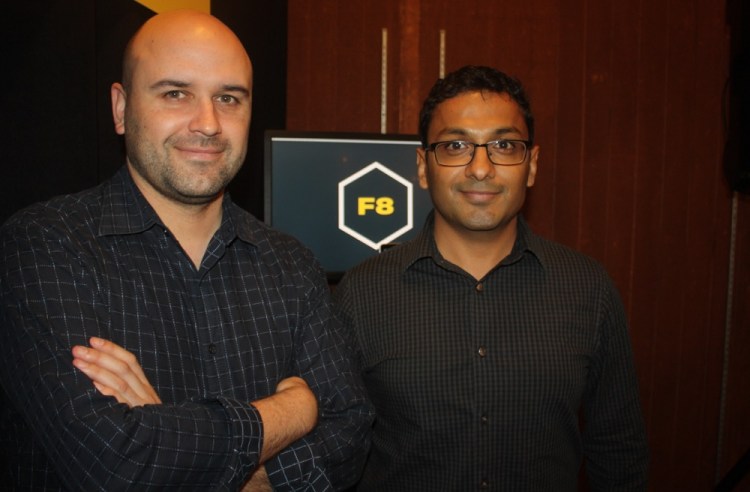If you want insights on how to monetize mobile and social games, go to Facebook.
That makes sense, as social company gets to see not only the performance of the network’s games but also the results of what happens when developers use Facebook ads to reach new mobile gamers.
We caught up with Dan Morris, head of strategic partnerships for games at Facebook, and Vishu Gupta, engineering manager at the company, at last week’s f8 conference in San Francisco for a discussion about monetizing mobile games and the latest platform changes that will help both game developers and players. Their tips may surprise you. But it’s based on both intuition and data, and the combination of these doesn’t lie.
Here’s an edited transcript of their advice.
GamesBeat: Dan, can you summarize what your monetization talk is about? What are some of your tips for monetizing games?
Dan Morris: The talk is called “The Seven Deadly Sins of Monetization.” It’s our effort to take platform-level insights about how games monetize well and how other people fail to monetize well, and produce real actionable advice for developers about how to make more money on the platform.
GamesBeat: What are some of those insights?
Morris: It’s meant to be easy. We want even relatively small companies to benefit. We have advice about the kinds of data to look at that they might not look at now. Tools to segment their audience in a more intelligent way. Just basic advice, but what’s good about it is we’re showing a lot of data across the ecosystem. The data tells the story of how many people are missing these opportunities. Here’s a chance to sound the alarm and let people know they may be missing some tricks.
GamesBeat: Does it apply to both Web and mobile?
Morris: This specific data we’re sharing is about our desktop platform. But there’s a lot of great insights into free-to-play games, how they work and how they monetize. I think they’ll be leveraged on a lot of different screens.
A great example is just A-B testing. Sometimes a counterintuitive approach to A-B testing can really work. The example we show is from Wooga. Wooga did a really inspired A-B test where they added a step to the flow of a discount offer. Normally you’d think that’s a no-no. Adding steps to a transaction tends to be a bad thing. But they added a quiz where users had to earn the offer. It turned out to be fun. As they ran the A-B test, the slightly longer version was more fun for users. It converted three times as well.
That’s the kind of insight that’s not going to be obvious to people, but when we show examples like this, we think people will be thinking more creatively about how to test.
GamesBeat: Would you call that gamification of an offer?
Morris: Yeah, you probably could, to overuse everyone’s favorite overused word.
GamesBeat: How would you come up with that idea?
Morris: That’s the beauty of what we’re trying to do with the talk. In isolation, you’re not going to come up with many of the ideas we’re going to share. What’s great is we can look across the whole platform and see all the good ideas at work. We’re trying to extract some common laws and some common advice from that. It’s mostly just a chance to share some of the great thinking that free-to-play game developers do as a population, so that everyone can get a bit better at this.
GamesBeat: Game companies are taking advantage of Facebook on mobile in a big way. Are there some lessons they’ve all gotten out of this that also come back as tips for monetization here? It’s a great way to target gamers, it seems.
Morris: The great advantage of Facebook, no matter what platform you’re on, is the audience we have and the level of detail we have about the audience. There are great opportunities, and they’re being capitalized on right now by a lot of smart companies to do focused user acquisition with us. It’s paying off. The nice thing is, it’s paying off now, and it’s still early in our discovery about everything that’s possible.
We have the ability to search for what we call lookalikes, segments of our user base that share a lot of data similarity to the people who are enjoying your game right now. By searching for those lookalike groups, you can find a very receptive audience for advertisements and engagement offers. Using that kind of audience data in a smart way is paying off for mobile game developers right now.
GamesBeat: Are pretty much all the game developers getting on board with this? Or is this also relatively early as far as them learning about these opportunities?
Morris: What’s early is the depth of sophistication for this system. But even now, it’s extremely effective. We’re getting a larger and larger percentage of game developers’ advertising budgets, because the tool works for them, even right now. It’s a great technique. When we talk to all the big mobile game developers, they’re spending a lot of time and effort to take fullest advantage of this.
GamesBeat: Do you have some other tips that are almost as good?
Morris: My main advice to mobile game developers right now would be to test and explore our mobile app install ads channel. There are many, many variables you can test against. There are lots of different sets of data you can target. I’ve seen some very innovative work that’s generated big returns on the marketing investment. It’s a great place to experiment.
GamesBeat: It sounds like King’s strategy was to iterate as much as possible on the desktop, on Facebook. Then, once they figured it out, it would take that game over to mobile.
Morris: They’ve not been shy about saying so publicly, which we’re obviously delighted about. They took advantage of the very open, fluid platform we run on desktop to tune their game in real time. They didn’t have to wait weeks for an app update. They were able to really nail it, and then deploy those changes on mobile to great effect. That’s a great feature of our platform.
GamesBeat: On desktop in general, it seems like there’s still a large base of gamers.
Morris: It’s a 250 million-strong audience. It’s been largely static. Revenue has actually grown. We’re in rude health in the desktop gaming business.



